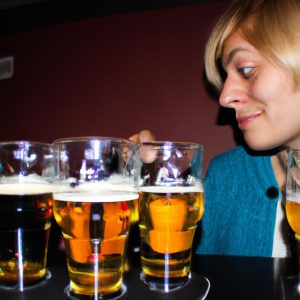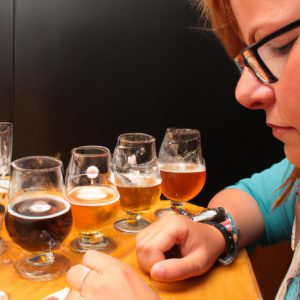Beer Tasting Techniques: Sniffing in Beer Reviews

Beer tasting is an art that requires a keen sense of observation and discernment. The process involves utilizing various techniques to fully appreciate the complex flavors and aromas present in different beer styles. One such technique, widely used among beer enthusiasts and reviewers, is sniffing or olfactory analysis. By carefully assessing the aroma of a beer, one can uncover subtle nuances and gain insights into its quality and characteristics.
Consider a hypothetical scenario where two beers of the same style are being compared – an IPA from a renowned craft brewery versus a generic mass-produced version. Upon pouring both beers into separate glasses, the first step would involve taking a moment to observe their appearance, noting any differences in color, clarity, or foam formation. However, it is during the second step – the act of sniffing – that crucial information about each beer’s unique qualities can be gathered.
Sniffing plays a vital role in evaluating beer as it allows for the detection of volatile compounds released by the liquid when agitated. These compounds include esters produced during fermentation, hop oils responsible for bitterness and aroma, as well as other aromatic molecules derived from malt grains or yeast metabolism. Through careful examination of these scents, experienced tasters can decipher intricate details like fruity notes indicative of specific hop varieties, malt sweetness or roastiness, yeast characteristics, and even potential off-flavors.
To properly sniff a beer, you should bring the glass up to your nose and take short, gentle sniffs. This allows you to capture the full range of aromas without overwhelming your senses. Start by taking note of any dominant scents that immediately stand out. For example, in an IPA, you might detect strong hoppy aromas such as citrus, pine, or tropical fruit notes. These can vary depending on the specific hops used in each beer.
Next, pay attention to any secondary aromas that contribute to the overall character of the beer. In an IPA, this could include malt aromas like caramel or breadiness, as well as fruity esters produced by the yeast during fermentation. These esters may add hints of banana, pear, or other fruit-like scents.
Finally, it is essential to assess the intensity and balance of the aromas in relation to each other. A well-crafted IPA should have a harmonious blend of hop aromatics with the malt and yeast-derived scents. If one component dominates excessively or if there are any unpleasant off-putting smells like sulfur or vinegar-like notes (indicative of potential brewing flaws), it may affect your perception of the beer’s quality.
Remember that everyone’s sense of smell is unique and subjective; what one person perceives might differ from another. However, with practice and exposure to various beers over time, you can develop a discerning nose for different beer styles and identify their key aromatic elements.
In summary, sniffing plays a crucial role in analyzing beers as it provides valuable information about their complexity and quality. By paying close attention to both primary and secondary aromas while considering their intensity and balance, you can deepen your understanding and appreciation for different beer styles during tastings.
Choosing the Right Glassware
Choosing the Right Glassware
Imagine you are attending a beer tasting event. As you approach the table, you notice an array of different glasses filled with various beers. Each glass is carefully chosen to enhance the drinking experience and bring out the unique characteristics of each beer. This attention to detail in selecting the appropriate glassware is crucial for ensuring that one can fully appreciate and evaluate the flavors and aromas present in different types of beer.
To begin with, let us consider why choosing the right glassware matters when it comes to beer tasting. The shape and design of a glass can significantly impact how we perceive a particular brew. For instance, a tall Pilsner glass showcases clarity and carbonation while maintaining a frothy head, which is essential for certain styles like lagers or pilsners. On the other hand, tulip glasses aid in capturing and concentrating aromatic compounds due to their bulbous bowl shape—making them ideal for aromatic beers such as Belgian Tripels or IPAs.
When evaluating various options for glassware selection during beer tastings, several factors should be taken into account:
- Shape: Different shapes influence aroma perception, carbonation levels, and presentation.
- Size: Consider whether you want to showcase color or maintain head retention.
- Material: Choose between traditional glass or more specialized materials like crystal or stainless steel.
- Etching/Patterning: Some glasses come with etchings at the bottom to promote bubble formation and release aromatics.
Now let’s take a closer look at some common types of beer glasses used in tasting events:
| Glass Type | Description | Suitable Beer Styles |
|---|---|---|
| Tulip | Bulbous bowl shape concentrates aromas towards your nose. | Belgian Ales, IPAs |
| Pint | Wide-mouthed allowing easy sipping; promotes showcasing colors. | Pale Ales, Stouts |
| Snifter | Wide bowl and narrow opening; captures aromas while allowing gentle warming. | Barrel-aged beers, Strong Ales |
In conclusion, selecting the appropriate glassware for a beer tasting event is crucial to enhance your overall experience. The shape, size, material, and etching of the glass all play significant roles in influencing aroma perception, carbonation levels, and presentation. By carefully choosing the right glassware based on these factors, you can ensure that you fully appreciate the flavors and aromas present in each unique brew. Now let’s delve into understanding different aroma profiles found in various types of beer.
[Transition Sentence] Moving forward, we will explore the art of understanding aroma profiles in different types of beer.
Understanding Aroma Profiles
Having discussed the importance of selecting appropriate glassware for beer tasting, let us now explore another crucial aspect of beer reviews – understanding aroma profiles. To truly appreciate a beer’s flavor and quality, one must pay close attention to its aromas. By engaging our sense of smell and employing specific sniffing techniques, we can uncover intricate notes that contribute to the overall sensory experience.
Sniffing in Beer Reviews:
To illustrate the significance of proper sniffing techniques, consider this hypothetical scenario: imagine two individuals sampling the same IPA. The first person takes a cursory whiff before diving into their first sip, while the second individual consciously engages with the beer’s aromas by utilizing various sniffing methods. Through careful observation, it becomes evident that these distinct approaches result in vastly different experiences and perceptions of the beer.
The following bullet points highlight how effective sniffing techniques enhance our ability to detect complex aromas and better understand a beer’s character:
- Deep inhalation allows volatile compounds in the beer to reach olfactory receptors.
- Slow exhaling after smelling helps identify lingering scents.
- Short sniffs help differentiate between primary and secondary aromas.
- Alternating nostril usage prevents olfactory fatigue during extended tastings.
Table: Common Aromas Encountered in Beers
| Aroma Category | Examples |
|---|---|
| Hoppy | Citrus, pine, floral |
| Malty | Caramel, bread, biscuit |
| Yeasty | Banana, cloves |
| Fruity/Esters | Apple, pear |
By employing these sniffing techniques and familiarizing ourselves with common aroma profiles found in beers—such as hoppy or malty— we can develop a more nuanced understanding of the flavors present. This not only enhances our own enjoyment but also enables us to provide detailed and informed reviews for others in the beer community.
Having explored the significance of sniffing techniques in uncovering aroma profiles, let us now delve into how these techniques can be applied to detect off-flavors in beers.
Sniffing Techniques for Detecting Off-Flavors
Imagine this scenario: you pour yourself a glass of beer, carefully selected from your favorite brewery. As you raise the glass to your nose, you anticipate an explosion of enticing aromas that will enhance your tasting experience. In this section, we delve into the art of sniffing and explore techniques that can help identify the diverse range of aromas present in various beer styles.
Sniffing is an essential step in evaluating the aroma profile of a beer. By engaging our olfactory senses, we can unlock a world of scents that contribute to the overall flavor experience. Here are some key techniques to master when exploring aromas:
- Short Sniffs vs Long Draws: Experiment with different sniffing methods to fully capture the nuances of each beer’s aroma. A series of short sniffs allows for quick detection of primary notes, while taking a slow, deep inhalation (a long draw) helps reveal more subtle complexities.
- Swirling Technique: Gently swirling the beer in your glass promotes evaporation and intensifies its aromatic release. This technique exposes hidden layers and provides access to additional fragrances within the beverage.
- Nasal Cleansing: To prevent olfactory fatigue, cleanse your nasal palate between samples by inhaling neutral odors like coffee beans or fresh bread. This practice clears away any lingering scents from previous beers and ensures accurate perception with each new evaluation.
- Mindful Observation: Pay close attention to what you smell without rushing to judgment or preconceptions about specific flavors. Engage all aspects of your senses as you assess qualities such as intensity, complexity, balance, and harmony.
Let us now explore these techniques further through a comparative analysis using three popular beer styles: IPA, Stout, and Belgian Tripel.
| IPA | Stout | Belgian Tripel | |
|---|---|---|---|
| 1. | Citrus, pine, and floral hop notes | Roasted malt, chocolate, coffee | Spicy phenols, fruity esters |
| 2. | High bitterness | Rich and velvety mouthfeel | Effervescent carbonation |
| 3. | Tropical fruit undertones | Dark chocolate and espresso | Sweet malty backbone |
| 4. | Resinous or dank aromas (depending on the variety) |
By incorporating these sniffing techniques into your beer tasting routine, you can unlock a wealth of aromatic experiences that enhance your overall enjoyment.
Next Section: Identifying Key Aromas in Different Beer Styles
Identifying Key Aromas in Different Beer Styles
Having explored the various sniffing techniques used to detect off-flavors in beer, we now turn our attention to identifying key aromas that define different beer styles. By honing our ability to recognize these distinct smells, we can enhance our understanding and appreciation of the complex flavors found within each brew.
To better comprehend how identifying key aromas contributes to a comprehensive review, let’s consider an example. Imagine you have poured yourself a glass of IPA (India Pale Ale) and are eager to delve into its aromatic profile. As you bring the glass closer to your nose and take a deep inhale, notes of citrusy hops immediately fill your senses. This aroma is indicative of the hop-forward nature typically associated with IPAs.
When conducting a beer tasting, recognizing specific aromas can be challenging due to the vast array of ingredients used during production. However, by focusing on certain aspects and employing effective sniffing techniques, one can discern distinctive fragrances unique to each style:
- Floral – characterized by delicate scents reminiscent of flowers or blossoms.
- Malty – evoking caramel-like or toasted grain aromas.
- Spicy – showcasing hints of clove, cinnamon, or other spices.
- Fruity – highlighting fruity notes such as apple, banana, or tropical fruits.
Table: Common Key Aromas Found in Different Beer Styles
| Beer Style | Primary Aroma | Secondary Aroma | Tertiary Aroma |
|---|---|---|---|
| IPA | Citrus | Pine | Tropical fruit |
| Stout | Roasted malt | Chocolate | Coffee |
| Wheat Beer | Banana | Clove | Citrus |
| Pilsner | Floral | Grassy | Herbal |
As reviewers and enthusiasts, recognizing these key aromas can provide a foundation from which to analyze and compare various beer styles. By referencing the table above, one can easily identify primary, secondary, and tertiary aromas associated with different types of beers.
Incorporating our newfound knowledge of sniffing techniques alongside an understanding of key aromas allows us to conduct more comprehensive beer tastings.
Transition into subsequent section:
With our noses primed to detect distinct aromas, let’s now delve into the ‘Three-Sip Method’ for tasting different beer styles.
Using the ‘Three-Sip Method’ for Tasting
Now, let us delve into the techniques involved in sniffing out these aromatic profiles and how they contribute to beer reviews.
To illustrate this point, consider a hypothetical scenario where two beers from distinct styles are being tasted: an IPA and a stout. Upon taking a whiff of the IPA, one might notice dominant hoppy notes with hints of citrus or pine. In contrast, the stout could emanate rich coffee or chocolate fragrances mingled with roasted malt undertones. These aromas provide valuable insights into what to expect from each beer’s flavor profile.
When evaluating the aroma of a beer, it is crucial to employ proper techniques for maximum discernment. Here are some useful guidelines:
- Cleanse your olfactory senses by inhaling fresh air or smelling unscented objects between samples.
- Hold the glass approximately an inch away from your nose to capture the full spectrum of scents.
- Take short sniffs initially to assess general characteristics before moving on to deeper inhalations.
- Try swirling the beer gently in its glass to release more volatile compounds for a fuller sensory experience.
By following these techniques, you can enhance your ability to identify and differentiate various aromas present in different beer styles.
Now that we have covered the methods for detecting key aromas, let us further explore their significance through an emotional lens using bullet points:
- The intoxicating aroma evokes anticipation and excitement about what lies ahead.
- Specific smells may trigger nostalgic memories associated with past experiences or places.
- Discovering new and intriguing scent combinations provides a sense of adventure and exploration.
- Sharing aromatic discoveries fosters connection among fellow enthusiasts and sparks conversation.
Furthermore, we can visualize these emotions by considering the following table showcasing examples of common beer aromas across different styles:
| Beer Style | Aromas |
|---|---|
| IPA | Citrus, Pine, Floral |
| Stout | Coffee, Chocolate, Roasted |
| Wheat Beer | Banana, Clove |
| Pale Ale | Caramel, Grapefruit |
In conclusion, the act of sniffing beer and identifying its key aromas is an essential part of the tasting experience. It allows us to appreciate the intricate nuances that contribute to each beer style’s unique character. By mastering these techniques and embracing the emotional aspects associated with scent exploration, we can elevate our enjoyment of beer even further.
Now let us transition into our next section about enhancing your beer tasting experience with food pairings.
Enhancing Your Beer Tasting Experience with Food Pairings
Building upon the three-sip method, another essential technique that beer enthusiasts employ to fully appreciate the complexities of a brew is sniffing. By using their sense of smell, they delve deeper into the aroma profile of different beers and enhance their tasting experience. This section will explore the significance of sniffing in beer reviews and how it contributes to our understanding of various flavors and aromas.
Sniffing plays a crucial role in identifying subtle nuances within a beer’s aroma. For instance, consider a hypothetical scenario where two individuals are sampling an IPA. The first person takes a sip without paying much attention to sniffing beforehand, while the second person carefully inhales the aroma before taking a sip. Upon tasting, both individuals might recognize hoppy bitterness initially; however, by engaging in pre-tasting sniffing, the second person may notice additional layers such as citrusy notes or floral undertones that were missed by the first individual.
To effectively utilize this technique during beer tastings, there are several key points to keep in mind:
- Take your time: Rushing through the process can lead to overlooking intricate details present in the beer’s aroma.
- Use proper glassware: Utilize appropriate glass shapes that concentrate aromas, allowing you to fully capture all olfactory sensations.
- Employ consistent techniques: Develop a standardized approach when evaluating different beers; this helps establish baseline comparisons between them.
- Consider temperature variations: The same beer at different temperatures can produce distinct aromas; experiment with serving temperatures to unlock new dimensions within each beverage.
In addition to these considerations, incorporating food pairings alongside your beer tastings can elevate sensory experiences even further. When paired correctly, certain foods can complement and enhance the flavors of a beer, creating a harmonious blend on your palate. For example, pairing a rich stout with dark chocolate or an IPA with spicy cuisine can create delightful flavor combinations that mutually intensify each other’s characteristics.
To illustrate this further, here is a table showcasing some classic food and beer pairings:
| Food | Beer |
|---|---|
| Grilled steak | Porter |
| Oysters | Pilsner |
| Lamb curry | Belgian Tripel |
| Blue cheese | Barleywine |
By incorporating sniffing techniques and exploring food pairings, you can enhance your overall beer tasting experience. These practices allow for a deeper appreciation of the intricate aromas present in different beers while simultaneously expanding your understanding of how they interact with various culinary delights.
In summary, by engaging our sense of smell through deliberate pre-tasting sniffing, we unlock hidden layers within a beer’s aroma profile. This technique enables us to identify subtle nuances that might otherwise go unnoticed. Combined with thoughtful considerations such as glassware selection, standardized evaluation methods, temperature variations, and food pairings, sniffing adds depth to our understanding of beer flavors and enhances our enjoyment of the entire sensory experience.



